The Bill T. Jones/Arnie Zane Dance Company collaborates with Anne Bogart’s SITI Company in “A Rite,” presented in the Richard B. Fisher Center’s Sosnoff Theater, July 6 and 7.
1913 was quite a year, and saying “Happy 100th Anniversary” mightn’t be the most appropriate salutation. Forget such minor irritations as the United States initiating an income tax. Think instead about artists who caused upheavals and provoked explosive reactions. In Paris, the premiere of Le Sacre du Printemps by Diaghilev’s Ballets Russes incited a riot in the theater, depending on whether one abhorred or adored Igor Stravinsky’s music, Vaslav Nijinsky’s choreography, and Nicholas Roerich’s costumes. In New York, wandering through the eighteen galleries at the Armory Show transported visitors from the familiar world views of, say, James McNeill Whistler and Edward Hopper to the shock of Pablo Picasso and Marcel Duchamp.
Angles battled curves, dissonance hammered at consonance, rough surfaces warred with refined ones, discontinuity threatened the accepted order. And World War I seethed toward its 1914 horrors, when its overture, the Second Balkan War, broke out months after the First Balkan War ended. Boundaries were breached and shifted; nations arose and fell and rose.
It was, I think, the intention of Bill T. Jones, Anne Bogart, and Janet Wong to capture in their 2013 A Rite, the productive and destructive elements boiling in Europe at that time, and the reverberations felt in art, science, culture, and everyday life. Sacrifice plays a role in A Rite, but there’s no sacrificial virgin chosen to dance herself to death in order to ensure that spring will come. There are no riots—either on the stage of Sosnoff Theater or among the spectators who’ve come to Bard’s Fisher Center for the opening event of Summerspace 2013. The primitivism that marked the imagined Russian tribes of the 1913 ballet edges obliquely in when a passage from Stravinsky’s Sacre, reimagined by Birdsongs of the Mesozoic, arouses a jazz-happy gathering bent on Charleston-ing the night away. The stylized poster at the back is of a black entertainer, which calls to mind the Parisian interest in another kind of “primitive” art—that from “l’Afrique,” where France had accumulated thirteen colonies.
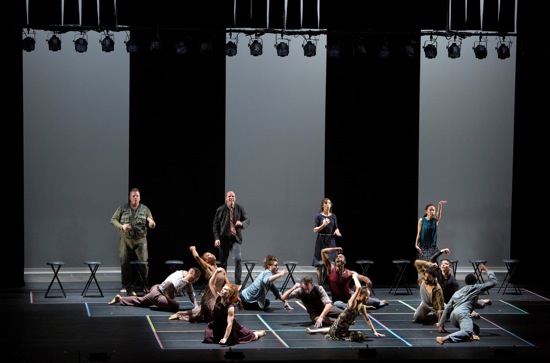
Unleashing A Rite. Foreground: Bill T. Jones/Arnie Zane Dance Company. At rear, L to R: SITI Company’s Leon Ingulsrud, Stephen Duff Webber, Ellen Lauren, and Akiko Aizawa. Photo: Cory Weaver
The collaboration of Jones and Bogart, whether or not the process was always peaceful, presents disruption onstage but undercuts it with cooperation. The six actors in Bogart’s SITI Company and the nine dancers in the Bill T. Jones/Arnie Zane Dance Company work with admirable skill and collegiality. When A Rite begins, they’re all moving wildly and individually—not to Stravinsky’s gentle, opening call but to the full orchestral fury of the final “Sacrificial Dance.” You’d be hard put, in most cases, to identify who is a dancer and who an actor (the two companies solved the distinction by calling them all “dactors”). Here Jones draws on Nijinsky’s choreography: the performers stand huddled forward, their bent knees shivering; like the women in photos of the 1913 ballet, they put one hand to a cheek and support its elbow with their other hand; in unison they fall and rise again; they jump up over and over, as did the Chosen Maiden.
The overall rhythm of A Rite is one of rushing on and off the stage, of moving and freezing, traveling forward through a sequence and retrograding it. Images coalesce in tableaux, then dissolve. Stools are tossed by hand to hand, put in place, sat on, removed. A piano is wheeled on. Or off. Stravinsky didn’t compose the section of his masterwork in order, and Jones and Bogart don’t present them in order. Cubism meets Stravinsky. Still, the score dominates and illuminates everything, whether a performer idly plays a few notes of the opening melody on the piano, or a character holds up a small cassette recorder) that emits a crackly recording, or Birdsongs of the Mesozoic jazzes up the music, stressing its syncopations. Three different major orchestras are heard, along with other groups. Robert Wierzel’s lighting abets the strangeness, the broken apart and oddly reassembled images.
When the tremendous score is dissected like this, you begin to hear it and admire it in new ways. One of the most wonderful passages occurs when I-Ling Liu sings a melody from the “Spring Rounds” section in a high, almost unreal voice to Lauren. Another happens when all the performers gather and sing a choral arrangement of (I think) the same part.
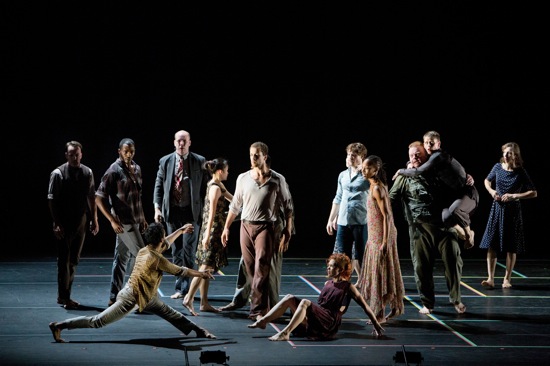
A Rite. Foreground: Erick Montes Chavero and Jenna Riegel. Rear, L to R: Barney O’Hanlon, LaMichael Leonard, Jr., Stephen Duff Webber, I-Ling Liu, Talli Jackson, Joseph Poulson, Shayla-Vie Jenkins, Leon Ingulsrud, Jennifer Nugent, Ellen Lauren. Photo: Cory Weaver
The spoken text, drawn from a number of sources, is a powerful ingredient—connected, yet disconnected. Two vivid SITI members do the most talking. Will Bond, shell-shocked and anguished throughout, speaks—sometimes stammers— words drawn from the testimonies of World War I veterans. When he is lifted or tossed about within the group, you can almost feel the convulsions of battle. The pinhead shell wounds on the back of his neck that he speaks of are intermittently referred to, as when Jenna Riegel several times soothes him. The most interesting verbal material, delivered by Ellen Lauren, is based on interviews with the distinguished musicologist Severine Neff (she is on the faculty of the University of North Carolina, where A Rite premiered in January). I don’t know whose beguiling idea it was to have Lauren wear spectacles and a nondescript dress (costumes by James Schuette) and speak with a down-home manner and a Lake Woebegon accent. She presents the news of the 1913 premiere and a fragmented analysis of the music—along with offhand contemporary references— as if she were doling out cookies to neighbors.
For instance, Leon Ingulsrud and La Michael Leonard, Jr. have been helping Akiko Aizawa to walk along a path of stools that others keep moving forward. Then Talli Jackson, Antonio Brown, and Barney O’Hanlon hold Aizawa high in the air and fly her over Bond’s head. Aiziwa dreamed, she says, “that sunrise was coming;” she recites a poem in Japanese. Then everyone clusters to walk along together, gesturing and smiling. So it seems to come from nowhere when Lauren begins: “If you think of it, if you think of it on an access. That like usually your melodies arpeggiate a triad, OK, that you have the chord going linearly and the chord going vertically. In this piece the chords are vertical but there is nothing linear.” And, as she talks on, the music for the “Ritual of the Rival Tribes” swells around her voice.
Stephen Duff Webber talks quite a lot, much of the time channeling Jonah Lehrer’s Proust Was a Neuroscientist, among other works. Webber speaks of alternate realities, of the human being as “a bag of particles.” While he discourses on this last, the performers circle Bond, bumping him as they pass.
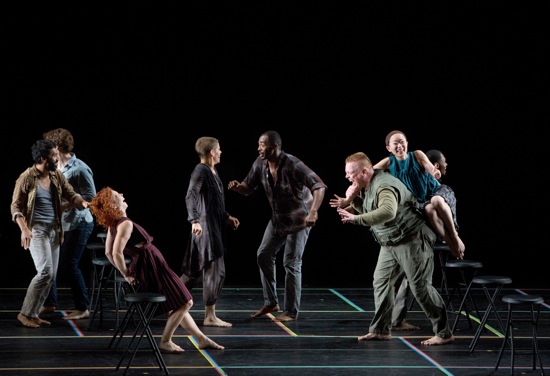
L to R: Erick Montes Chavero, Joseph Poulson, Jenna Riegel, Jennifer Nugent, LaMichael Leonard, Jr., Leon Engulsrud, Akiko Aizawa, Antonio Brown. Photo: Cory Weaver
In fact, everyone gets to talk—at least a little. A modest, relatively polite version of the pandemonium at the premiere of Rite of Spring occurs when the cast members move the stools into a line at the front of the stage and—in single words or short, chopped phrases— dispute a changing array of issues. Order and disorder in the music, harmony and disharmony (in life as in art), war and peace, performers and spectators, what it was like to work on A Rite. In the end, Stravinsky drowns out their arguing, and they pick up their stools and go.
You might ask, “Is there dancing in all this?” Yes, but not for its own sake. Every passage of movement portrays tumult or facilitates stability and comradeship. Erick Montes Chavero has a wild solo moment. So does Jennifer Nugent. Various people are lifted and turned and flipped. All join in various groups to form gestural tableaux. At the opening of the second part, when the music depicts the circle that Nijinsky’s maidens walked in (she who stumbled most becoming the victim), all the performers walk in pairs, entering, one couple at a time, through the central opening in the black hangings at the rear, and feeding into an accumulating and de-accumulating pattern that obliges partners to separate into symmetrical circles, meet again, and exit. It’s not as simple as it sounds.
Each performer comes to the forefront briefly, whether with words, gestures, or more strenuous movement. Whom have I not mentioned yet? Shayla-Vie Jenkins? Joseph Poulson? Just typing their names is enough to make me see them in action.
Bond, as the angry, soul-wounded soldier, threads his way through everything—sometimes joining, sometimes not. At the end, Jones and Bogart invoke the post-traumatic stress disorder that plagues returnees from the war in Iraq and the violence that sometimes results. The implication is that this man sacrificed his sanity in the service of his country, and that idea merges with another iconic contemporary tragedy: mass shootings by a single gunman with almost unlimited ammunition. Bond mimes killing Riegel, his helpmeet, then everyone else. One by one, they spin to the floor and die. The high drama and the killing do match the climax of the original Rite of Spring, but the obviousness of the political message unsettles me.
The ending is even more ambiguous than it is in Stravinsky’s scenario. The coming of Spring (or hope) takes the form of the “dead” rising, helping one another up, and walking slowly offstage. Meanwhile, at the back, slim black ribbons descend, and behind them, Bond travels with big movements across the stage. The effect is, uncannily, almost that of a strobe light; he flickers, jolts, yet keeps going.
Like many immersed in dance, I’ve seen a number of works set to Stravinsky’s score, including Millicent Hodson and Kenneth Archer’s scholarly, yet imaginative reconstruction of the 1913 work for the Joffrey Ballet. This is the first new one to pull me into the music and its history in so many unexpected and provocative ways.

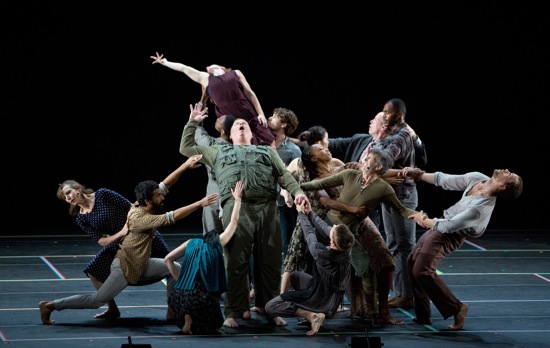
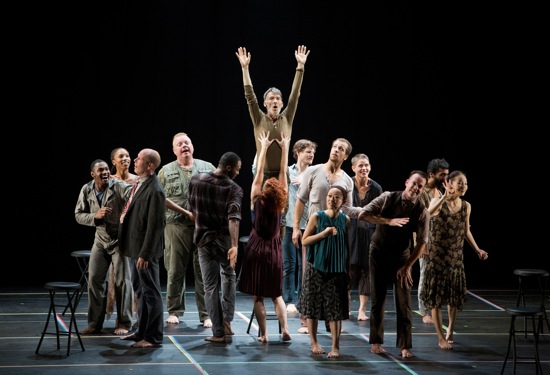
I have always admired, deeply, Bill T. Jones’s sense of history, not to mention Deborah’s. How brilliant to put Sacre in the context of western events and I hope this version comes my way. I am struck, as well, in the photographs, by the performers’ physical similarity to members of the Bill T. Jones/Arnie Zane company, decades ago. Thanks Deborah for evocative, thoughtful writing, once again.
Sacre comes with such a fraught history, I’m always thrilled (and slightly surprised) when a choreographer chooses to take it all on. We’ve all seen different approaches to the score and its context — Jones seems to have done what I would expect him to do, and matched the significance of the historic work with substance of his own.
Thank you for this piece, Deborah. I made the journey up from NYC to see A Rite. You have captured here all of the elements that were well-woven into a new piece to honor the music and time of its composition/reveal. I appreciated A Rite’s complexity but have found it so difficult to describe it to colleagues because as an audience member you are constantly receiving and processing information from so many layered sources of input: visual art references, text, movement, lighting, and composition. Viewing the performance in the inspirational Gehry space also added an element of time/place. At times I couldn’t help but see similarity between the “cubist” choreographic tableaus onstage you mention and imagine how the architecture reflected something similar around us. As always, your writing is expert in dissecting and honoring all of the individual parts that contributed to the provocative whole. No question that A Rite is a wonderful new work of art by Jones, Bogart, and Wong but I personally enjoyed being a participant in what also felt like a theatre-wide neuroscience experiment.
Deborah,
Thank you so much for this fabulous piece !
I will read your amazing piece – several times.
I send you my gratitude for your generous ‘ gift ‘
of unmatched talent & virtuosity.
With Perpetual Admiration & Gratitude,
Catherine Kirsch
( NYU/TSOA : Scarlotti Deconstruction Dancer & Graduate Seminar Student )
I think this is among the such a lot significant info for me.
And i’m happy reading your article. However want to observation on some basic issues, The website taste is ideal, the articles is in point of fact nice : D. Just right process, cheers